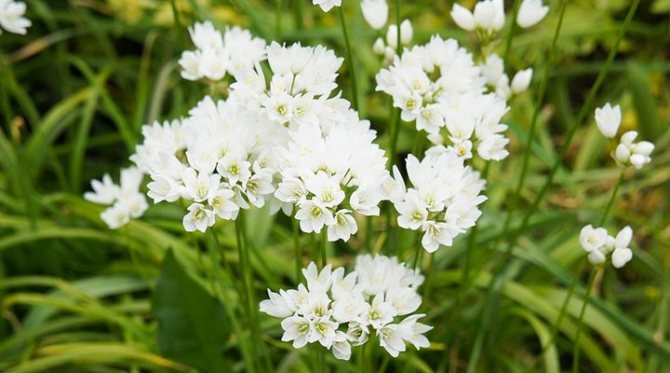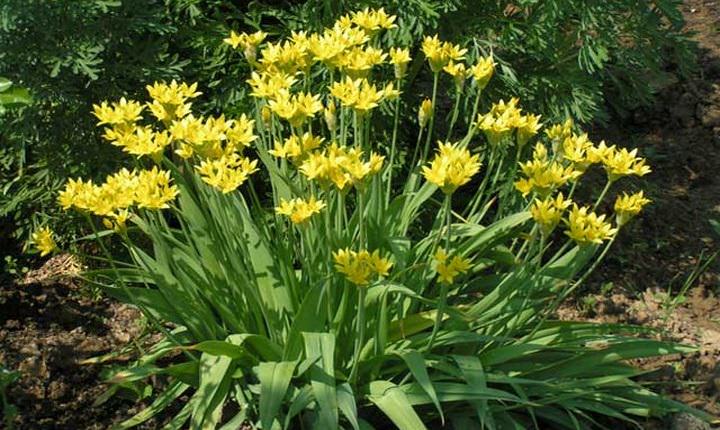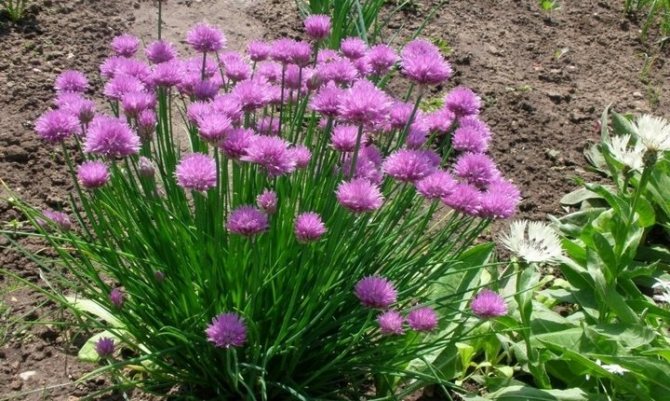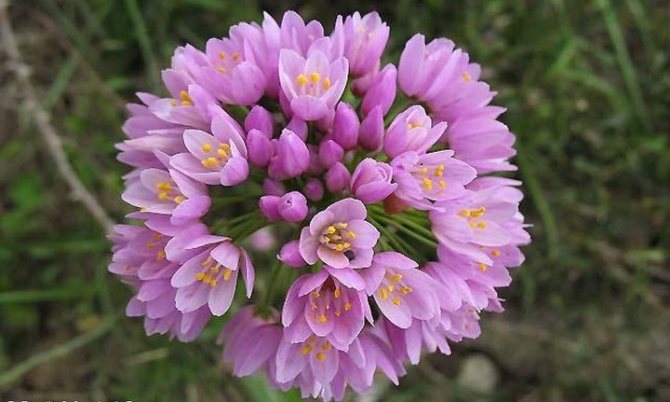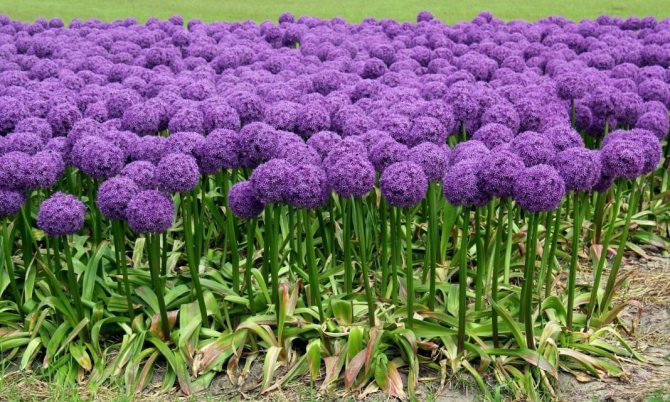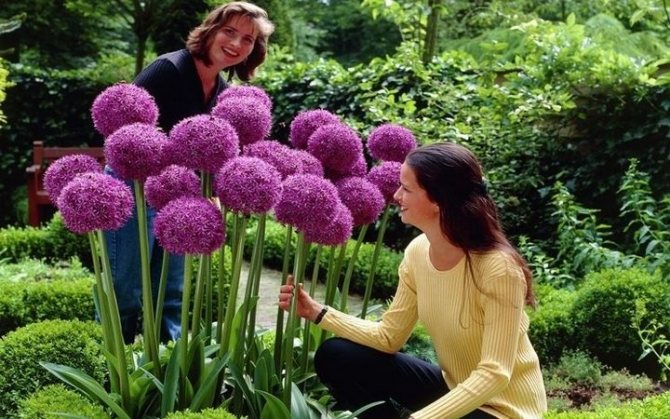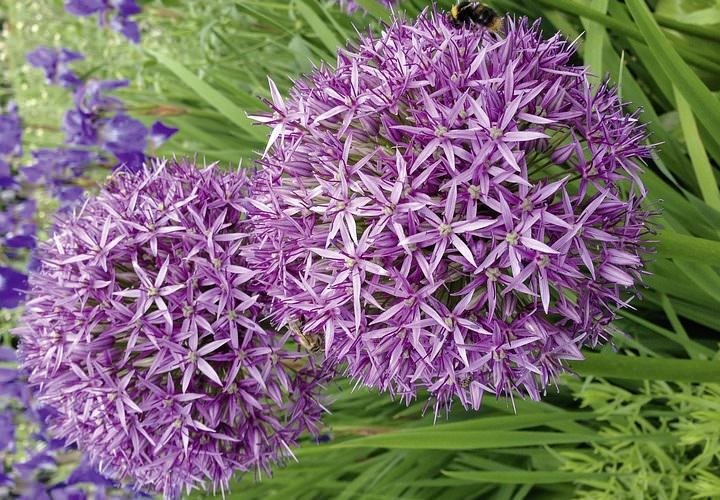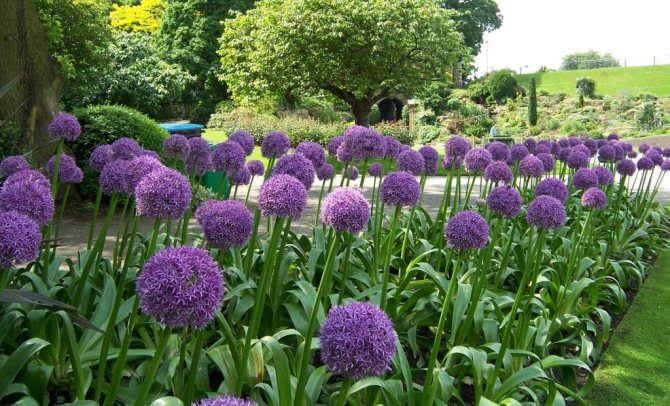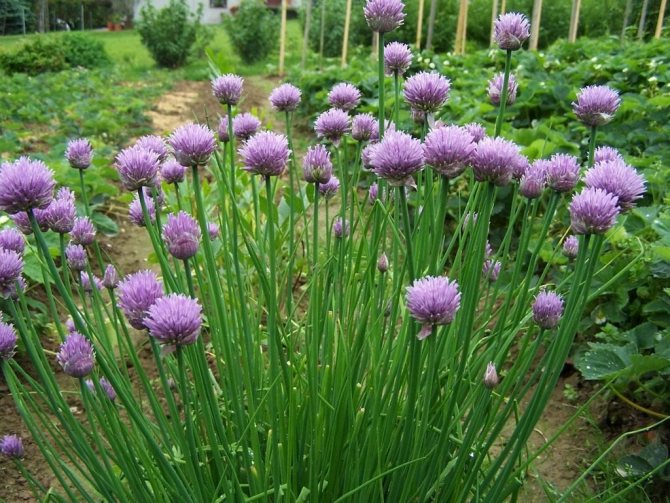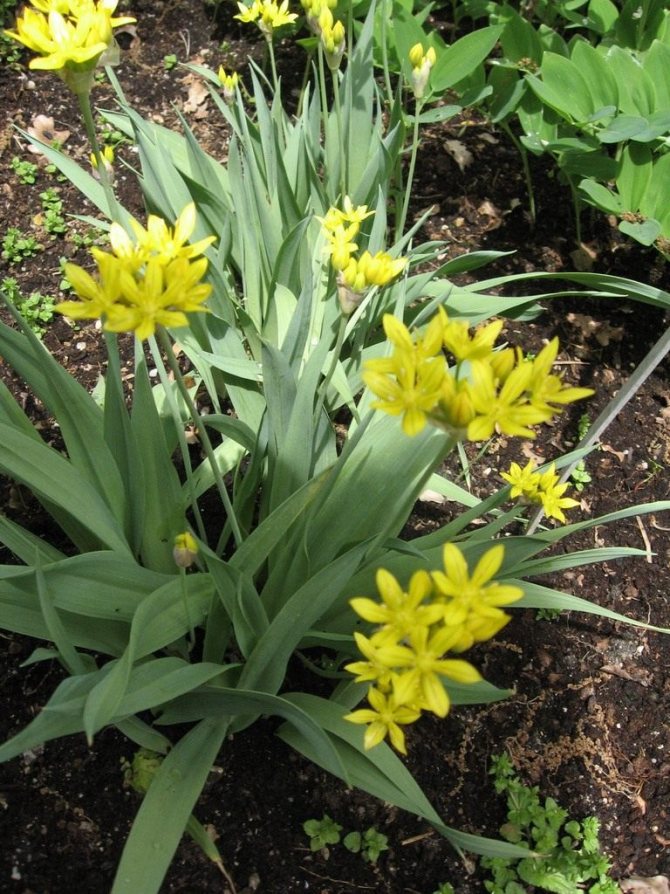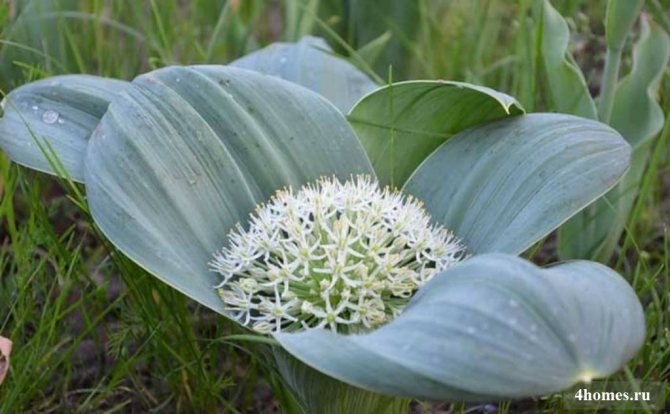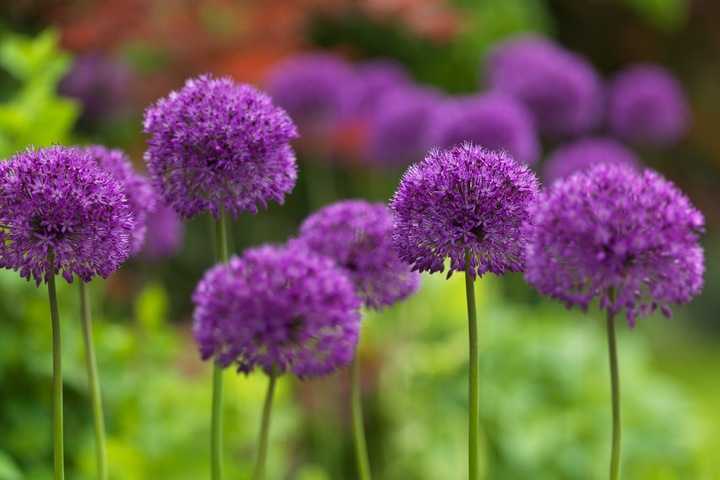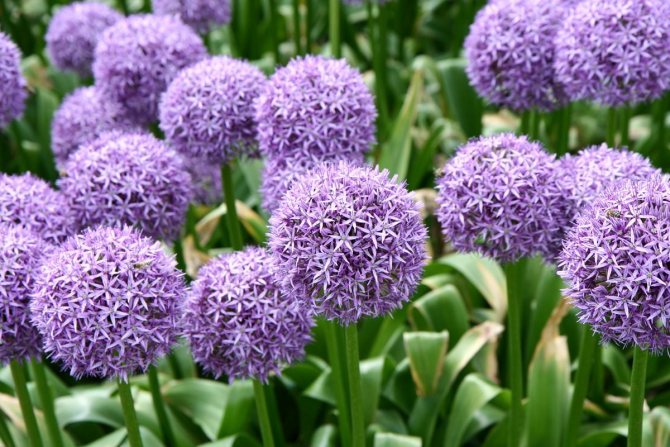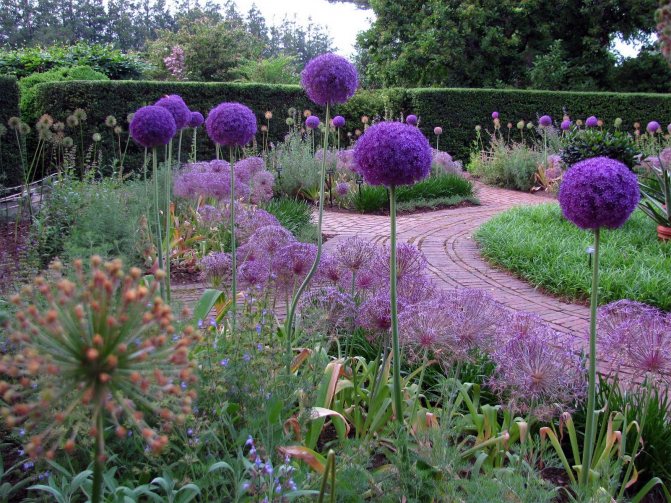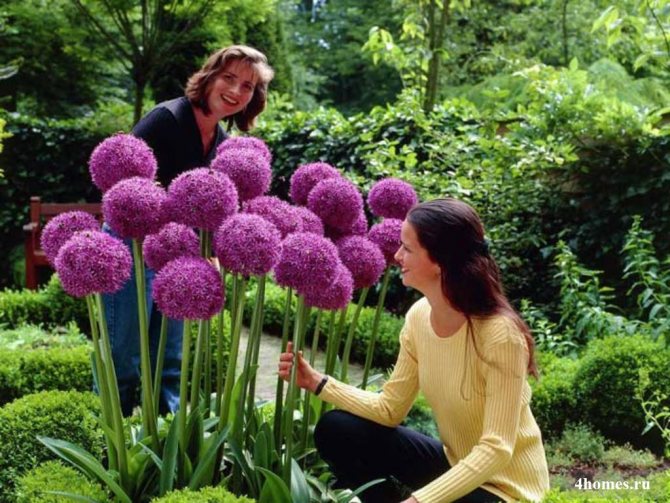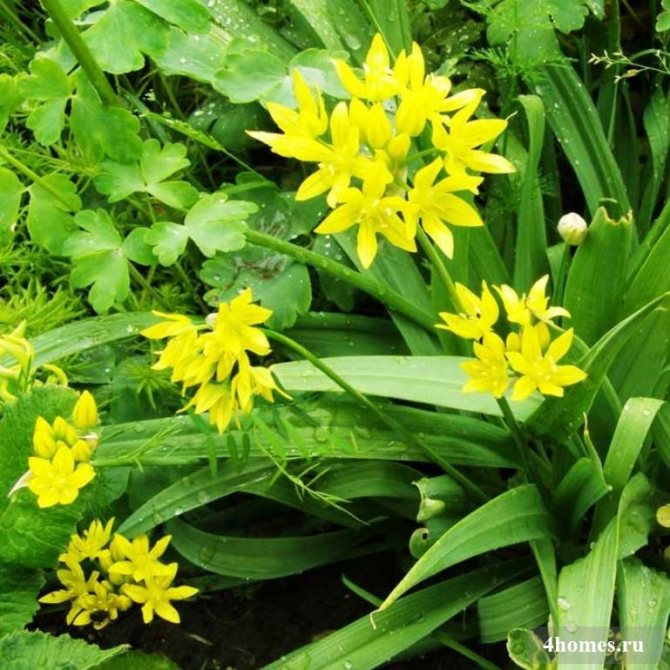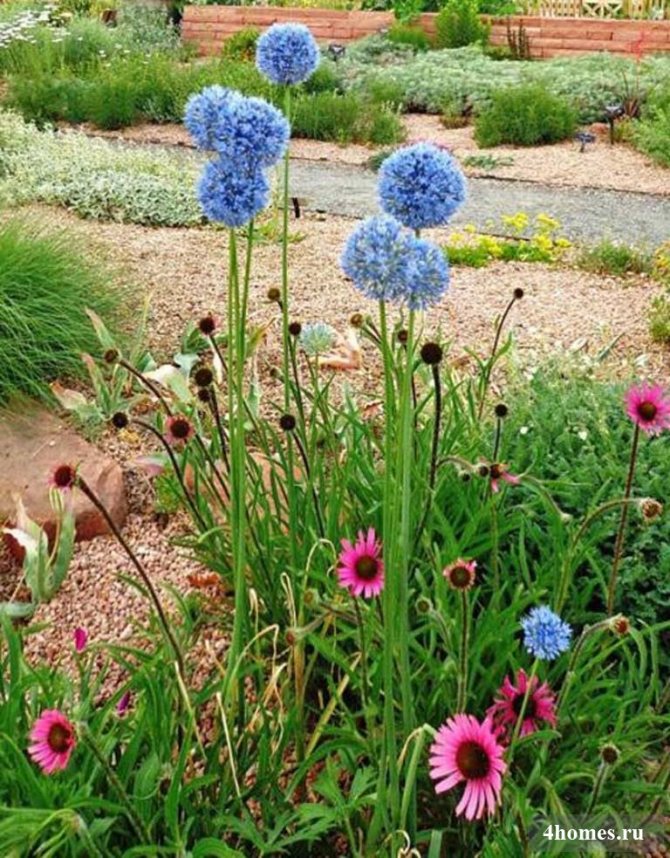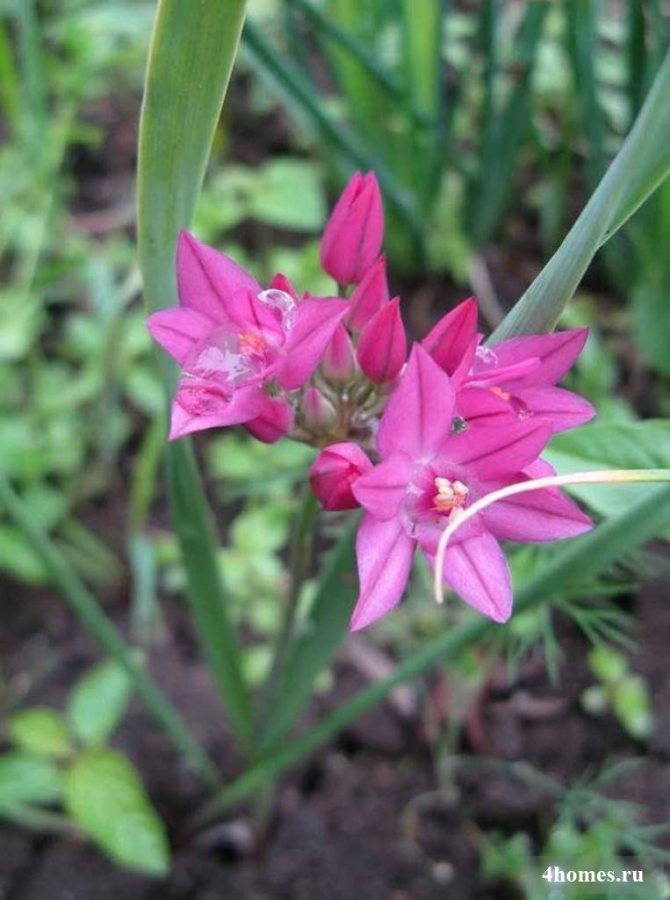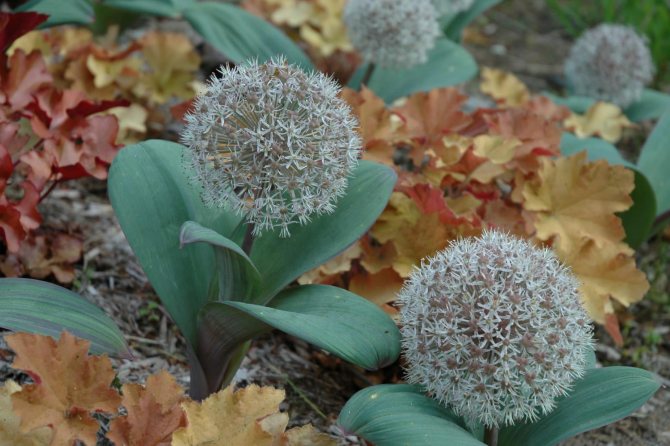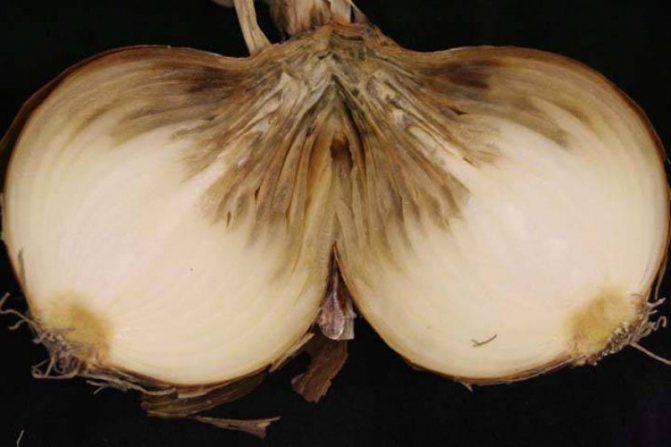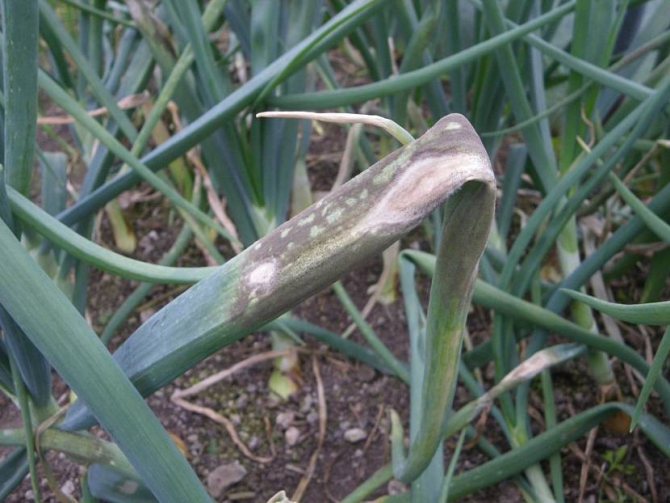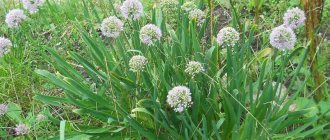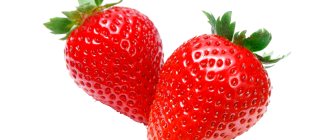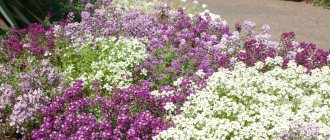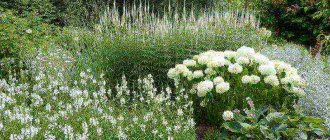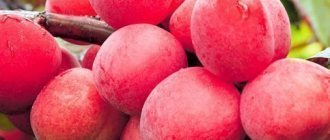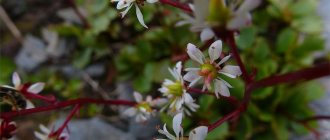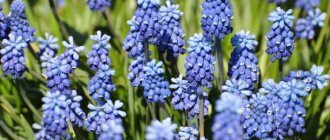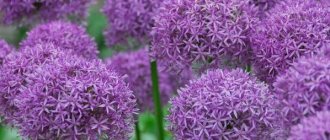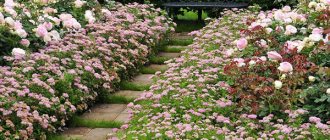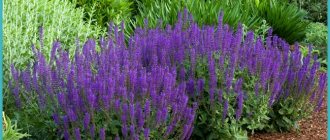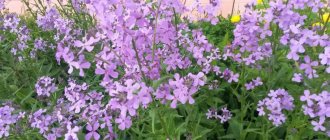The decorative Allium onion is a unique plant. It will completely revive any flower garden.
Certain varieties can be used for food purposes, like onions and garlic. Indeed, translated from Latin, allium means garlic.
The inhabitants of ancient Rome, therefore, called this culture for its special aroma and specific taste.
Allium is completely unpretentious, equally loves shade and sunny areas. Low-lying plots where rainwater accumulates are not suitable for him. It is important for these plants that the air penetrates into the soil.
Decorative bows are used to decorate decorative fences. They are accepted quite well in various flower beds, they allow you to form an excellent design, and are perfectly accommodating with neighbors.
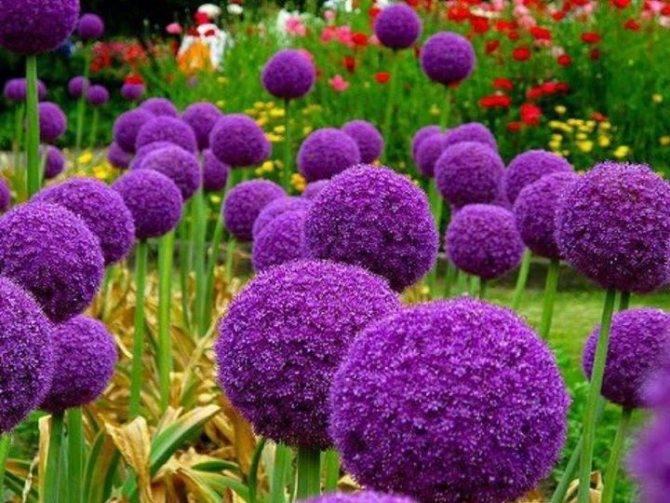
Types and varieties
Popular varieties:
| View | Description | Flowering time |
| Giant | As tall as a human being. Purple spherical flowers, consisting of small star buds, have a diameter of up to 15 cm. | May-early June. |
| Round-headed | Inflorescences are pink or burgundy. Oval, with a circumference of up to 3 cm. | Second half of summer. |
| Pretty | Small purple flowers, collected in umbellate inflorescences. | August. |
| Karatavsky | The peduncle is buried deep in the ground. The leaf plates are wide with a reddish or pink frame. The flowers are white or purple. | June. |
| Gold | Flat inflorescences-umbrellas with a circumference of up to 7 cm yellow. They resemble miniature lilies. | |
| Ostrovsky | The flowers are lilac-crimson, reminiscent of a pentagram. They have six petals. Three of them, located after one, are shorter. The leaves are elongated and thin, without a specific onion aroma. | |
| Christophe | Lilac flowers are star-shaped. Collected in large inflorescences, up to 25 cm in circumference. They do not fade for 1.5 months. They fade, but do not fall off, but harden and dry out. | |
| Inclined | The leaf plates are flat, fan-shaped at the rhizome. The flowers are pinkish or snow-white on legs reaching 50 cm. | Mid-August. |
| Schubert | Pedicels from 2 to 20 cm. Inflorescences are purple with greenish-pink flowers. | May-July. |
| Blue Ceruleum | Violet-blue spherical inflorescences are placed on an elongated stalk. They have a diameter of 2-7 cm. | Late spring-early summer. |
| Sicilian | Delicate pink or milky bell flowers bent to the ground with straight legs. Bees make onion honey from pollen. | April May. |
| Pskemsky | The leaves are cylindrical. 2-3 cm thick. Inflorescences are snow-white in the form of a hemisphere. | Early July. |
| Oblique (ukun, mountain garlic) | Leaves and bulbs are edible. Inflorescences are yellow with many stamens sticking out to the sides. | June July. |
| Roseum | Inflorescences-bells are large, snow-white-pink, pale lavender. The diameter of the flowers is up to 8 cm. For the winter, a pot is transplanted. The plant is brought into the room, because afraid of the cold. | May June. |
| Gladiator | Up to one and a half meters high. The lilac or purple inflorescence has a diameter of 25 cm. | June. Lasts 2 weeks. |
| Giganteum | Grows up to 150 cm. Lilac inflorescences no more than 10 cm. | Late spring-early summer. |
| Bulgarian | The flowers are claret-white. Up to 90 cm high. | May June. |
| Amethyst | Red Mohican Perennial grows up to 100 cm. Burgundy-snow-white flowers 5-7 cm. | June July. |
| Forlock | Dark purple inflorescences 5-6 cm high up to 60 cm. | |
| Ivory Queen | The leaves are corrugated, elongated and wide. Grows up to 40 cm. | End of May-June. |
| Summer beauty | Inflorescences are delicate lavender. Fade slowly to a creamy white. Do not give seeds. They keep their shape for several months. | July. |
| Aflatunsky | The bulb is cone-shaped with a sharp end, covered with grayish scales. Leaf plates are gray-green, elongated, ribbon-like. The plant is edible. | May June. |
| Bearish | It grows up to 40 cm. Inflorescences are umbrellas, consisting of star-shaped snow-white flowers. | |
| Victorious | Reaches 70 cm. Flowers are white-green. |
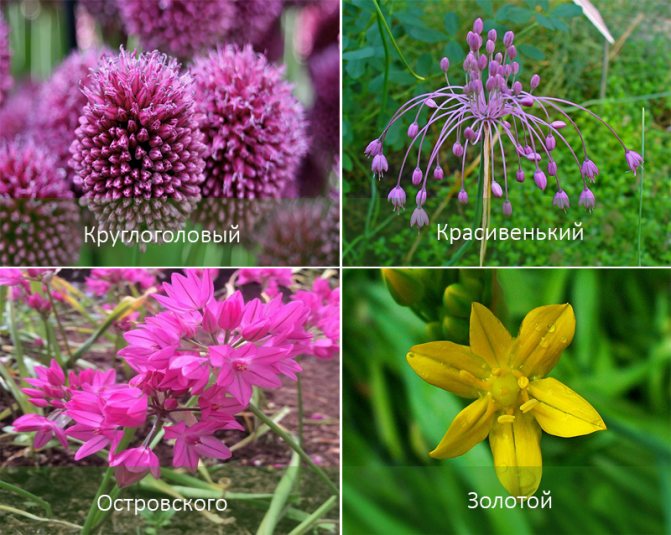

Popular varieties: description, characteristics
An unusual plant is also good because it has a huge number of species. Therefore, it is not difficult to make a choice.
Giant
The Giant Bow is also known as the Giant Bow or Anzur, Titan. The flowering period covers the end of spring - the first week of summer. The plant pleases the eye not only with elegant purple inflorescences, but also with ellipsoidal green leaves.
Note! The average diameter of the inflorescence is 14-16 cm, inside there is a huge number of tiny flowers-stars.
The plant arrived in Russia from Central Asia, and can reach a height of more than 1.5 meters.
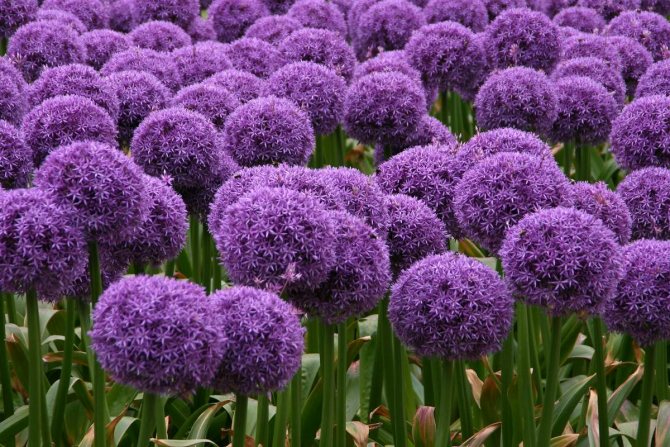

The Gigantskiy variety fully justifies its name.
Allium
It is a herbaceous perennial. Allium onion has the following characteristics:
- Stem height - up to a meter.
- The spherical inflorescence consists of a huge number of small flowers.
- Long slender leaves emerging from the root rosette.
- The duration of flowering can be from June to September.
Planting and leaving
Planting and caring for a plant does not take much time. Onions love the sun; partial shade is also suitable for planting. Higher varieties (such as siculum) should be planted in areas sheltered from the wind so that gusts do not break the stems. The plant will take root well in moderately fertile, light soils. Allium needs good drainage. When stagnant, the bulbs begin to rot.
Purchase
You need to choose strong, large, fleshy bulbs of cream tones, without dryness and mold. Planting material with new shoots is not recommended.
Open ground planting technology
Outdoor cultivation takes place in autumn or spring:
- The soil is dug up. Humus and wood ash are introduced to enrich the substrate with potassium.
- Bulbs are planted in moistened pits. Planting depth is equal to three sizes of the bulbous head. The distance between the holes is 30-50 cm.
- The soil is mulched.
Onions are grown and seedlings:
- seeds are sown in a substrate consisting of humus, peat and turf;
- sprouts dive;
- seedlings are periodically taken out to fresh air for hardening before planting in open ground;
- plants are transplanted to a permanent place after 2-2.5 months;
- the moistened planting holes are 10 cm deep.


Planting technology in room conditions
Planting in indoor conditions step by step:
- The pot is chosen deep, with a lot of holes for drainage. Excess water will kill the plant.
- On the bottom of the planter, a drainage layer of fine gravel, perlite is laid out.
- Soil is poured on top, a bulb is planted in it.
- The planting material is sprinkled with a substrate, the soil is slightly compacted.
- The earth is watered. If necessary, add soil (there should be a distance of 1.5-2 cm to the top of the planter).
Care features
When watering, you must adhere to the following recommendations:
- Stagnation and excess water is more destructive for the plant than its lack.
- Moderate watering is needed during the growing season. When leaves and inflorescences are formed.
- Watering is done as needed. More often in dry weather. In the rain - as the top layer of the soil dries up.
Top dressing rules:
- Top dressing is done during the growing season. This helps the plant to cope with the increased stress.
- In the spring, they are fed with nitrogen-containing mixtures.
- In summer, mineral feeding is recommended.
- In September, dry phosphate-potash fertilizers are used. They prepare the allium for winter.
- In the cold season, it is mulched with humus, peat.
Ornamental bow care
1. Ornamental onions grow on oxygen-rich soil, so the soil under the plant must be loosened periodically.
2. It is necessary to deal with weeds, while the onion is not very much grown. And in order to prevent the appearance of weeds, apply mulching.
3. In the spring, decorative onions need feeding, which is carried out with the use of mineral fertilizers, which contain a lot of nitrogen-containing substances. Phosphorus and potassium are added in the fall.
4. Allium is resistant to dry periods, abundant watering is not needed.
5. When the leaves dry up, the bulbs are dug out to plant in the fall or spring.
6. This culture does not tolerate a rainy summer - it begins to rot.
Reproduction
Allium is propagated by:
- bulbs;
- seed;
- bulbs;
- dividing the rhizome.
In the first case, it is not recommended to sow underdeveloped seed pods. Otherwise, the plant will have a dull color. In this way, onions of almost any kind are bred. The disadvantage of this method is that the allium will bloom only in the third year at best.
With vegetative reproduction, flowering is observed already in the first year. However, this method will not be able to breed all types of allium: many do not give "children", not all have a rhizome suitable for division.
Some varieties of allium produce bulbs. These are small bulbs located not in the ground, but on the top of the peduncle.
Growing conditions
All of the listed onion varieties adapt well to the conditions, but the plants show their decorative effect best when they are planted on a well-lit lawn. It is important to protect crops from gusts of wind. To do this, it is necessary to provide for the presence of some kind of artificial barrier nearby. It can be a board fence or a dense shrub that does not block the sun's rays.
Ornamental varieties of onions do not tolerate stagnant water at the roots. Therefore, experienced gardeners prefer to plant bulbs on a small hill, where melt water leaves in the first place.
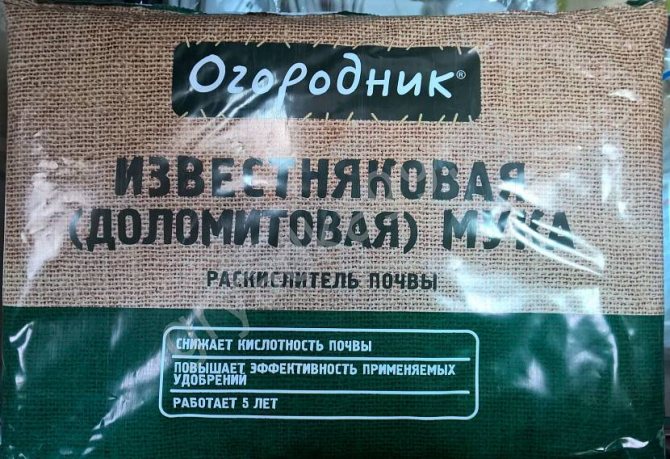

Soil deoxidizer - dolomite flour Source
High acidity of the soil is also undesirable for plants. If there is such a soil on the site, you should not give up planting a decorative onion. A one-time application of slaked lime (at the rate of 300 grams per one square meter) or dolomite flour will help to correct the situation. It is sold in specialized stores, the manufacturer indicates the dosage on the packaging. Compliance with it eliminates the possibility of unwanted side effects.
Landing
The bulbs are planted in the garden bed. Fertile soil does not need fertilization, if instead of it there is loam on the site, you first need to dig up the earth, add 5-7 kg of rotted compost, superphosphate and sulfate to it at the rate of 30 grams per square meter, as well as wood ash.
In the finished soil, holes are made 2.5 cm deep. The bulb is buried in them by 1-2 cm. The holes are placed in a heap, seven pieces per section, it is important to leave a distance of 40 cm between adjacent such sections.
Diseases and pests
Onions are affected by the following diseases and insects:
| Disease / Pest | Damage | Control measures |
| Peronosporosis | Blurry greenish spots appear on the foliage. A gray-violet mycelium is formed in the form of a plaque. Greens turn yellow, become brown, dries up. | The diseased foliage is collected.The bushes are processed with commercially available means (Bordeaux mixture, copper oxychloride, kartotsid, ridomil). |
| Rust | In the spring, orange plaques are observed on the greenery. After a while, red-yellow spores form. The foliage dries up. | Affected leaves are destroyed. Onions are sprayed with preparations containing copper (copper oxychloride, Bordeaux mixture). |
| Smut | Dark gray stripes appear. The leaf plates and pedicels are bent. | |
| Heterosporia | The foliage turns yellow, covered with a brown bloom. The greenery dries up, the yield deteriorates. | |
| Cercosporosis | Damage appears in early summer. Clear gray spots with a thin yellowish border are formed on the leaves and stems. The affected areas do not rot. Greens turn yellow and dry out. | |
| Golden bronze | It is a large green insect with a bronze, golden tint. Reaches 14-20 mm. If you look at the photo, you can see transverse white lines on the wings. The larvae are thick, snow-white, up to 60 mm in length. Pupa yellowish, formed in an earthen cocoon. Pests fly from May to late summer. | Beetles and larvae are collected. |
What is the bow
This word denotes completely different plants. This group even includes garlic, which is also considered an onion. Depending on the external characteristics, onion varieties are distinguished:
- Onion - grown for greens and root crops.
- Shallots - many small, irregularly shaped bulbs grow in one nest. Cultivated for collecting feathers and turnips.
- Batun - does not form bulbs, it is used to obtain green mass.
- Slime is grown for greens. Its leaves are flat, 8-15 cm wide.
- Schnitt - there is no turnip, the green feather can be eaten, it is often grown as an ornamental plant.
- Leek is a false bulb that turns into a white stem, eaten.
- Multi-tiered - has several bulbs that form on the leaves.
In the photo, types of onions with names.
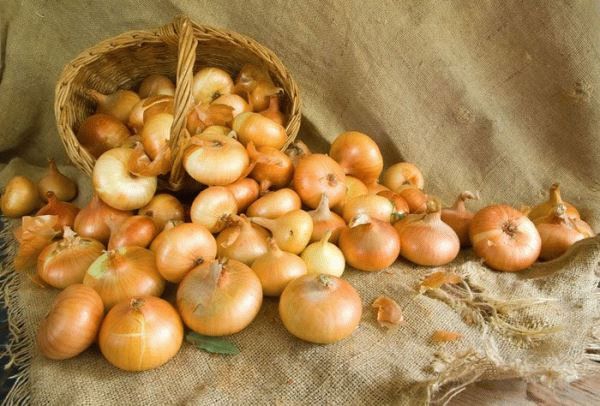

Bulb onions
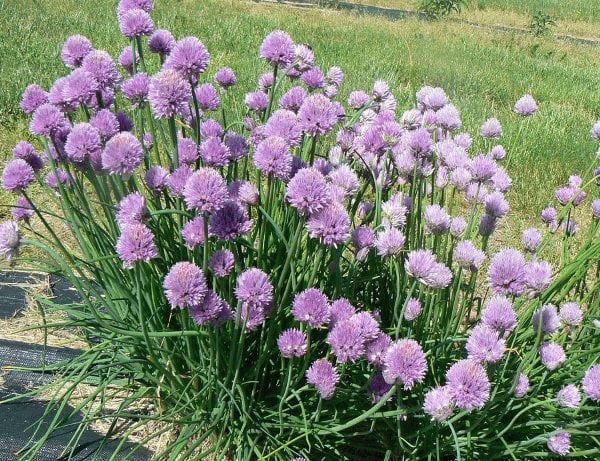

Chives
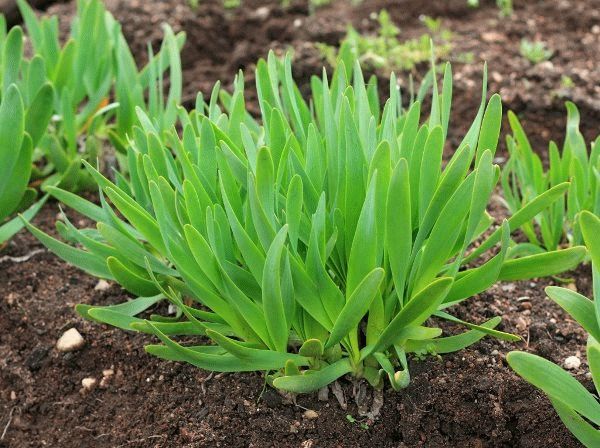

Slime onion
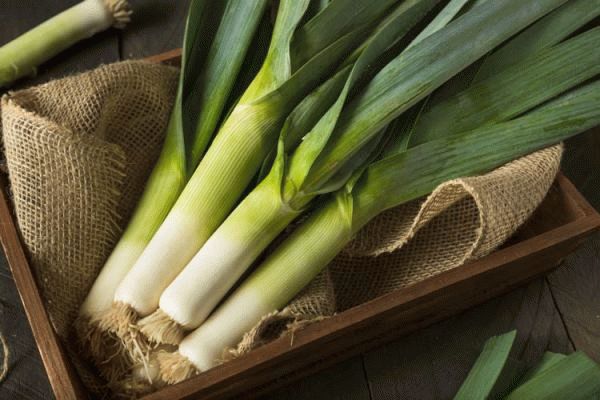

Leek
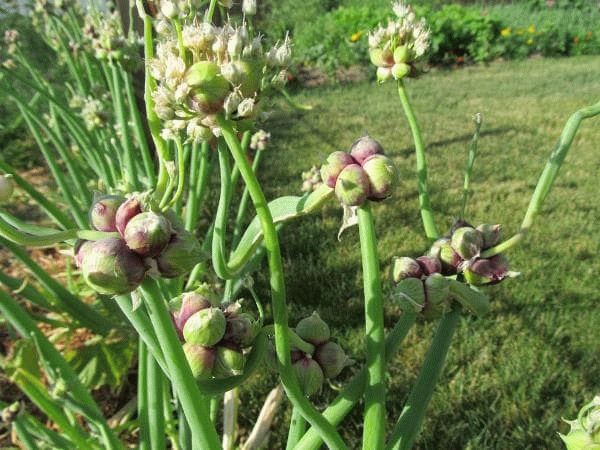

Tiered bow
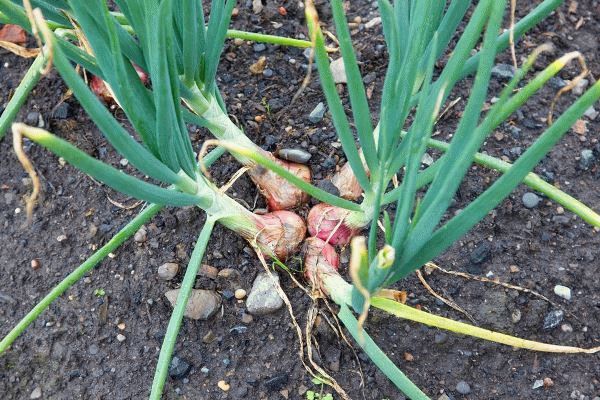

Shallot
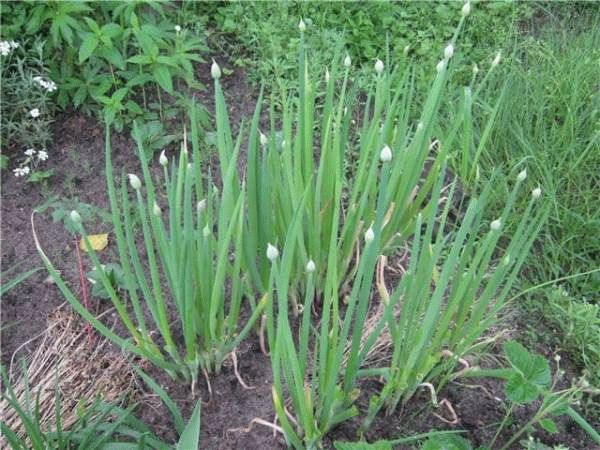

Batun onion
All varieties of crops have separate varieties, which determine how it looks, is grown, eaten, and the crop is stored. Green onions can be cultivated as a perennial plant in one place for about 5 years or more. Size, taste, external characteristics differ in each type. To obtain a turnip, seed is sown or planted every year.
Use in landscape design
For the design of rock gardens and rocky hills, varieties are used:
- karatavsky;
- pskemsky;
- summer beauty.


Landscape parks are decorated with an allium:
- Aflatunsky;
- victorious;
- giant;
- bearish;
- Globemaster.


On flower beds and borders in the landscape, slime, angular, chisel, chameleon look aesthetically pleasing. Neapolitan and pink decorative onions are used for forcing.
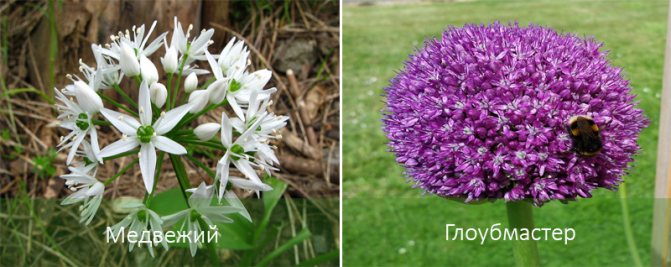

Large varieties are recommended to be planted throughout the flower garden (eg Mount Everest). Place small varieties in containers. Blooming alliums will decorate any plot of land.
The best green compositions
Today, decorative bows are widely used in landscape design. Low-growing species are ideal for creating group plantings. Peonies, roses, poppies, hostas, geraniums grow well next to them, if you choose the right colors, you get very beautiful modules. Usually onion varieties are planted in the middle of the composition, then other plants cover their withering foliage with their foliage.
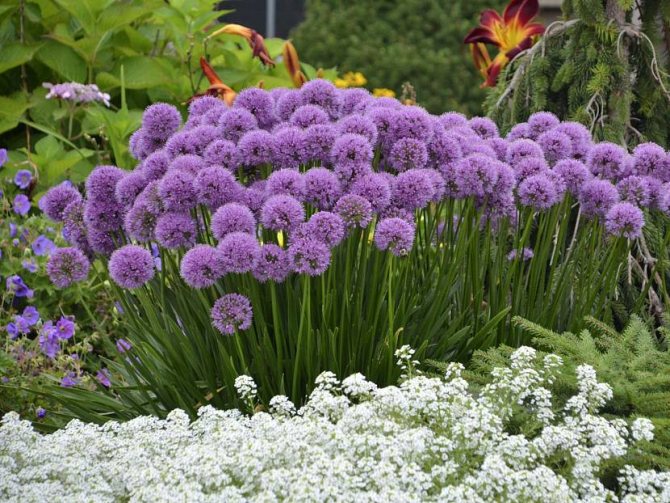

Ornamental onions are especially good in group plantings Source
Landscaping modules that are entirely composed of decorative bows are called allaria. When these plants are in bloom, they look great. But since the spicy plant has a persistent specific smell, it will not be possible to admire the allaria for a long time.That is why such elements are arranged inside the garden, away from the walking alleys, where their beauty remains accessible for contemplation, and the fragrance is quickly dispelled by a light breath of the wind.
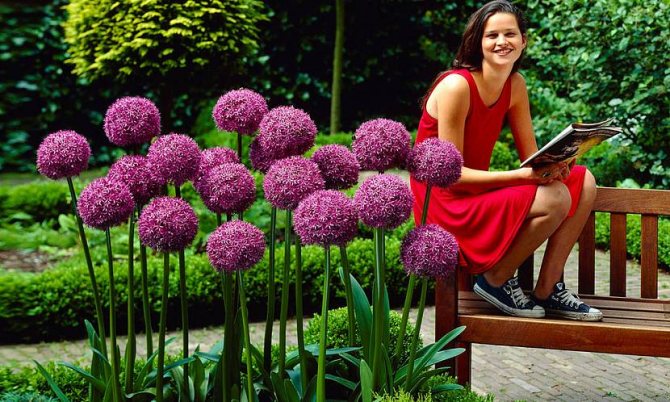

Allium giant in human height Source


